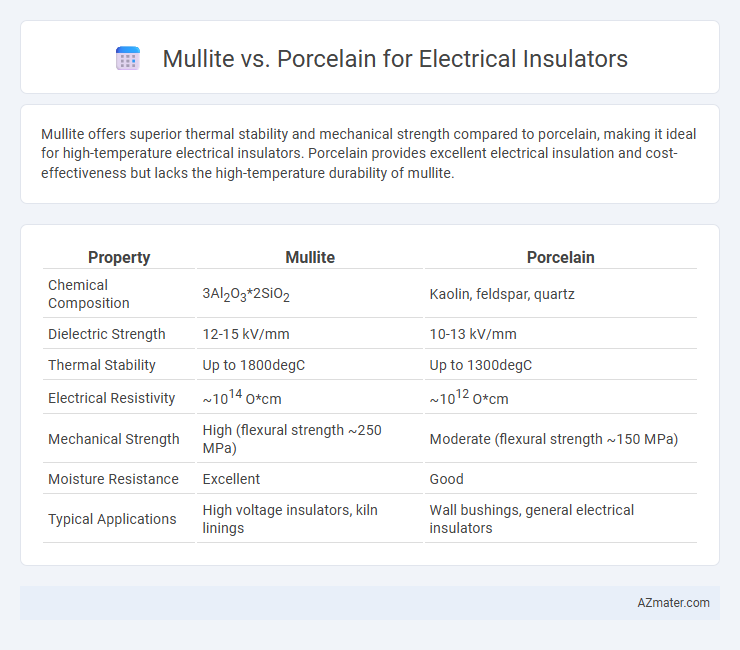Mullite offers superior thermal stability and mechanical strength compared to porcelain, making it ideal for high-temperature electrical insulators. Porcelain provides excellent electrical insulation and cost-effectiveness but lacks the high-temperature durability of mullite.
Table of Comparison
| Property | Mullite | Porcelain |
|---|---|---|
| Chemical Composition | 3Al2O3*2SiO2 | Kaolin, feldspar, quartz |
| Dielectric Strength | 12-15 kV/mm | 10-13 kV/mm |
| Thermal Stability | Up to 1800degC | Up to 1300degC |
| Electrical Resistivity | ~1014 O*cm | ~1012 O*cm |
| Mechanical Strength | High (flexural strength ~250 MPa) | Moderate (flexural strength ~150 MPa) |
| Moisture Resistance | Excellent | Good |
| Typical Applications | High voltage insulators, kiln linings | Wall bushings, general electrical insulators |
Introduction to Electrical Insulators
Electrical insulators such as mullite and porcelain play a critical role in preventing electrical current flow by offering high dielectric strength and thermal stability. Mullite, with its superior thermal shock resistance and low electrical conductivity, is preferred in high-temperature electrical insulation applications. Porcelain provides excellent mechanical strength and moisture resistance, making it ideal for outdoor insulator components in power transmission systems.
What is Mullite?
Mullite is an alumino-silicate ceramic characterized by high thermal stability, low thermal expansion, and excellent electrical insulation properties, making it ideal for electrical insulators in high-temperature applications. Compared to porcelain, mullite exhibits superior resistance to thermal shock and mechanical strength, enhancing performance in harsh industrial environments. Its unique microstructure contributes to low dielectric loss and high insulation resistance, critical for reliable electrical insulation.
What is Porcelain?
Porcelain is a ceramic material composed primarily of kaolin, feldspar, and quartz, known for its excellent electrical insulation properties and high mechanical strength. It provides strong dielectric resistance and thermal stability, making it widely used in electrical insulators for power transmission and distribution. Compared to mullite, porcelain offers superior moisture resistance and a more refined surface finish, enhancing its performance in outdoor and high-voltage applications.
Material Composition: Mullite vs Porcelain
Mullite, composed primarily of 3Al2O3*2SiO2, offers superior thermal stability and low dielectric loss compared to traditional porcelain made from kaolin, feldspar, and quartz. The higher alumina content in mullite enhances its electrical insulation properties, making it more resistant to high voltage and thermal stress. Porcelain's varied mineral composition provides good mechanical strength but lower thermal endurance and increased susceptibility to moisture absorption, affecting long-term insulation performance.
Mechanical Properties Comparison
Mullite exhibits superior mechanical strength and thermal shock resistance compared to porcelain, making it ideal for high-stress electrical insulator applications. Porcelain, while offering excellent dielectric properties and chemical stability, generally has lower fracture toughness and higher brittleness. The enhanced mechanical resilience of mullite results from its unique crystal structure, which provides better fracture resistance and durability under mechanical load.
Thermal Stability and Performance
Mullite exhibits superior thermal stability compared to porcelain, maintaining structural integrity at temperatures exceeding 1700degC, which makes it ideal for high-temperature electrical insulators. Porcelain, while effective up to around 1300degC, tends to exhibit lower resistance to thermal shock and deformation under prolonged heat exposure. Mullite's enhanced thermal performance ensures reliable insulation and durability in demanding electrical applications requiring high-temperature resistance.
Electrical Insulation Capabilities
Mullite exhibits superior electrical insulation capabilities compared to porcelain due to its higher dielectric strength and lower dielectric loss, making it ideal for high-voltage applications. The intrinsic chemical stability and thermal shock resistance of mullite enhance its performance as an electrical insulator in harsh environments. Porcelain, while effective, typically has lower breakdown voltage and is more susceptible to moisture absorption, which can reduce its insulating efficiency over time.
Durability and Lifespan
Mullite offers superior durability and thermal stability compared to porcelain, making it highly resistant to cracking and deformation under high electrical and thermal stress. Porcelain, while widely used, is more prone to mechanical wear and moisture absorption, which can reduce its lifespan in harsh environments. Mullite's enhanced chemical inertness and lower thermal expansion contribute to a longer service life in electrical insulation applications.
Cost and Manufacturing Considerations
Mullite offers superior thermal stability and mechanical strength compared to porcelain, making it more suitable for high-temperature electrical insulators, though it generally incurs higher raw material and processing costs. Porcelain remains a cost-effective choice due to its established manufacturing methods and lower material expenses, though its performance can degrade under extreme thermal stress. Manufacturing techniques for mullite involve precise sintering and controlled atmosphere, which elevate production complexity compared to the more straightforward glazing and firing processes used for porcelain.
Best Applications: Choosing Between Mullite and Porcelain
Mullite offers superior thermal stability and electrical insulation, making it ideal for high-temperature and high-voltage electrical insulator applications such as power transformers and circuit breakers. Porcelain excels in mechanical strength and moisture resistance, which suits outdoor insulators and distribution systems exposed to harsh environmental conditions. Selecting between mullite and porcelain depends on operational temperature ranges and environmental exposure, with mullite preferred for extreme heat and porcelain favored for durable, weather-resistant applications.

Infographic: Mullite vs Porcelain for Electrical insulator
 azmater.com
azmater.com